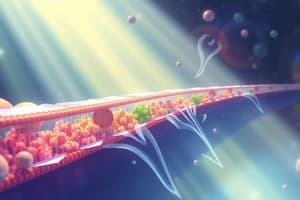Podcast
Questions and Answers
What is active transport?
What is active transport?
Molecules move across the plasma membrane against their concentration gradient.
What is facilitated diffusion?
What is facilitated diffusion?
A molecule moves down its concentration gradient using a transport protein in the plasma membrane.
How does water cross the plasma membrane?
How does water cross the plasma membrane?
Through facilitated diffusion or diffusion.
What is the sodium-potassium pump an example of?
What is the sodium-potassium pump an example of?
What does endocytosis describe?
What does endocytosis describe?
Energy is conserved. This means that in any system, _____
Energy is conserved. This means that in any system, _____
Potential energy is _____ energy.
Potential energy is _____ energy.
Which of the following is highest in chemical energy?
Which of the following is highest in chemical energy?
In cellular respiration, when is most energy released?
In cellular respiration, when is most energy released?
An enzyme is considered a _________ because it speeds up a chemical reaction without being used up.
An enzyme is considered a _________ because it speeds up a chemical reaction without being used up.
In a catalyzed reaction, a reactant is often called a _________.
In a catalyzed reaction, a reactant is often called a _________.
An enzyme is specific because of the shape its ______ ____ matches only particular reactants.
An enzyme is specific because of the shape its ______ ____ matches only particular reactants.
An enzyme speeds up reactions by lowering the __________ ______.
An enzyme speeds up reactions by lowering the __________ ______.
The _______ ___ between an active site and its substrate often strains bonds and helps the reaction proceed.
The _______ ___ between an active site and its substrate often strains bonds and helps the reaction proceed.
A ________, which is often a vitamin, binds to an enzyme and plays a role in catalysis.
A ________, which is often a vitamin, binds to an enzyme and plays a role in catalysis.
High temperatures or changes in pH can ________ an enzyme, causing it to lose its shape and biological activity.
High temperatures or changes in pH can ________ an enzyme, causing it to lose its shape and biological activity.
In oil-based liquids, phospholipids are arranged so that their _____ face outward and their _____ are orientated inward.
In oil-based liquids, phospholipids are arranged so that their _____ face outward and their _____ are orientated inward.
The movement of molecules from an area of higher concentration to an area of lower concentration is called _____.
The movement of molecules from an area of higher concentration to an area of lower concentration is called _____.
When water moves toward the solution with the _____ solute concentration, the solution is _____.
When water moves toward the solution with the _____ solute concentration, the solution is _____.
Which of these reactions is endergonic?
Which of these reactions is endergonic?
Enzymes are used up when they catalyze a chemical reaction.
Enzymes are used up when they catalyze a chemical reaction.
Passive transport requires no expenditure of cellular energy.
Passive transport requires no expenditure of cellular energy.
What is osmosis?
What is osmosis?
Seawater is dangerous to drink because...
Seawater is dangerous to drink because...
Which of the following statements about the ATP molecule is true?
Which of the following statements about the ATP molecule is true?
What is feedback inhibition?
What is feedback inhibition?
Flashcards are hidden until you start studying
Study Notes
Membrane Transport and Cellular Processes
- Active Transport involves movement of molecules against their concentration gradient, requiring energy.
- Facilitated Diffusion uses transport proteins to move molecules down their concentration gradient without energy expenditure.
- Water can cross the plasma membrane via facilitated diffusion or directly through the lipid bilayer.
- The sodium-potassium pump, an example of active transport, uses ATP to move sodium ions out and potassium ions into the cell.
- Endocytosis is when the plasma membrane engulfs external material, forming vesicles.
- Exocytosis is the process where vesicles fuse with the plasma membrane to release contents outside the cell.
Energy Concepts
- Energy is conserved, meaning the total input equals total output within a system.
- Kinetic Energy is energy in motion; Potential Energy refers to stored energy.
- One molecule of Glucose is the highest in chemical energy compared to other molecules.
- In cellular respiration, energy is mainly released when high-energy electrons transition to lower energy levels.
- An enzyme acts as a catalyst, speeding up reactions without being consumed.
- A substrate is a reactant in an enzyme-catalyzed reaction.
Enzyme Functionality
- Enzymes are specific due to the unique shape of their active sites that match specific substrates.
- Enzymes lower the activation energy, facilitating reactions.
- The induced fit model describes how enzyme binding can strain substrate bonds, aiding the reaction.
- Coenzymes, often vitamins, assist enzymes in catalysis.
- High temperatures or pH changes can denature an enzyme, altering its shape and function.
Membrane Structure and Function
- Phospholipids in oil-based liquids arrange with hydrophobic tails outward and hydrophilic heads inward, offering protection.
- Diffusion refers to the movement of molecules from higher to lower concentration areas.
- Solutions with greater solute concentrations are termed hypertonic.
- Passive transport, such as diffusion and osmosis, does not require ATP; instead, it relies on concentration gradients.
Osmosis and Water Transport
- Osmosis is driven by the water concentration gradient, not directly by solute concentration.
- Water flows to areas of lower free water concentration across semipermeable membranes.
- Drinking seawater, which is hypertonic to bodily fluids, leads to dehydration through osmosis.
Energy in Biological Systems
- Endergonic reactions absorb energy, while exergonic reactions release it.
- ATP provides energy for cellular work by releasing a phosphate group.
- Inhibition of enzyme reactions can occur through competitive inhibitors, which bind at the active site, or noncompetitive inhibitors, which bind elsewhere.
Thermodynamics in Biology
- The first law of thermodynamics states energy cannot be created or destroyed.
- The second law of thermodynamics indicates that energy transformations always increase the universe's overall disorder, or entropy.
- Cellular energy that is not utilized contributes to increasing disorder, primarily through heat.
Cellular Processes and Transport Types
- Phagocytosis describes large particles engulfing by cells, a contrast to standard endocytosis mechanisms.
- Aquaporins are specialized proteins that facilitate water transport across membranes.
- Feedback inhibition regulates enzyme activity based on product concentration, maintaining homeostasis within cells.
These bullet points encapsulate essential concepts from membrane transport and energy dynamics within biological systems, providing a comprehensive overview for study.
Studying That Suits You
Use AI to generate personalized quizzes and flashcards to suit your learning preferences.




